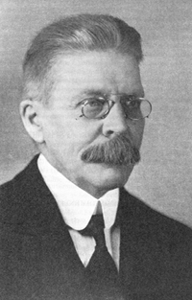Aimo Kaarlo Cajander
Aimo Kaarlo Cajander [ ˈɑi̯mɔ ˈkɑːrlɔ ˈkɑjɑndɛr ] (born April 4, 1879 in Uusikaupunki / Finland ; † January 21, 1943 in Helsinki ) was a Finnish forest scientist , geobotanist and politician . Its official botanical author's abbreviation is " Cajander ". One of his sons, Aimo Aarno Antero Kalela (Cajander until 1935) (1908–1977), was a botanist.
Life
Cajander began studying biology in 1903, and from 1904 he studied forest sciences at the University of Munich . From 1911 to 1934 he was Professor of Forest Science and Silviculture at the University of Helsinki and from 1934 to 1943 Director General of the Finnish Forest Administration.
In addition to his academic work, Cajander was also a politician and as such was Prime Minister of Finland from 1922 to 1924 and from 1937 to 1939. He also chaired the National Progressive Party from 1937 to 1939.
Cajander also gave the "equipment model" of the Finnish army during the Soviet-Finnish war (1939-1940) the name ( Cajander model ). Since only those Finnish soldiers who were currently in training had uniforms and rifles during the attack on the Soviet Union , most of the newly drafted soldiers, many of whom were unserved, had to bring their own weapons with them. They also came in their private clothing and were given badges to identify them as combatants in accordance with the Hague Land Warfare Regulations .
As a professor of silviculture in Helsinki, he researched the structure of forest communities and is considered one of the founders of the northern European school of vegetation ecology .
In his plant sociological classification, which he published in 1909, the societies are not differentiated and named according to the dominant type of tree layer, but according to the predominant plants of the herb-dwarf shrub layer and the soil layer (moss-lichen cover). It assigns a certain type of forest to all those stands that are characterized by the same floristic composition and the same ecological-biological properties of the plants of the lower layer when they are mature and when the trees are closed.
Fonts
- The Alluvionen of the lower Lena-Thales, Volume 1; 1903
- Contribution to the knowledge of the vegetation of the alluvion of Northern Eurasia; 1903
- Studies on the vegetation of the primeval forest on the Lena River; 1904
- The Alluvionen des Onega-Thales, Volume 2; 1905
- Contribution to the knowledge of the vegetation of the alluvion of northern Eurasia; 1908
- The Alluvions of the Tornio and Kemi Valleys, Volume 3; 1909
- About forest types; 1909
- The cultivation of foreign wood species as a forest and plant geographical problem; 1923
- Forest geographical overview of Finland; 1923
- About the relationship between forest growth and wood consumption in Finland; 1923
- About the distribution of the fertile soil in Finland and about the influence of this distribution on the economic conditions in the country; 1923
- What is the purpose of the forest types ?; 1923
- The forestry importance of forest types; 1926
- The theory of forest types; 1926
- Nature and significance of forest types; 1927
- The organization of forest research in Finland; 1931
- Tieteellinen tutkimustyö sekä korkein opetis maatalouden ja metsätalouden alalla; 1931
- Le Comité national du fonds d'assistance pour la population civile de Finlande pendant la guerre entre la Finlande et l'Union soviétique, et après: conférence […]; 1940
- Forest types and their significance; 1949
- The mutual struggle in the plant world; no year
Web links
- Literature by and about Aimo Kaarlo Cajander in the catalog of the German National Library
- Author entry and list of the described plant names for Aimo Kaarlo Cajander at the IPNI
| personal data | |
|---|---|
| SURNAME | Cajander, Aimo Kaarlo |
| BRIEF DESCRIPTION | Finnish forest scientist, geobotanist and politician |
| DATE OF BIRTH | April 4, 1879 |
| PLACE OF BIRTH | Uusikaupunki , Finland |
| DATE OF DEATH | January 21, 1943 |
| Place of death | Helsinki |
